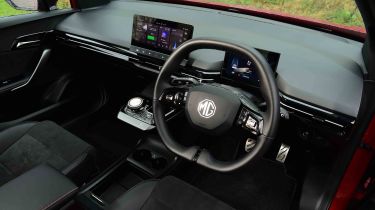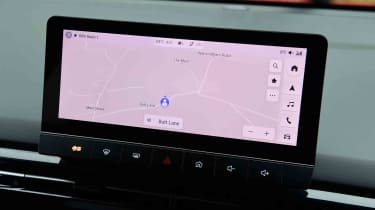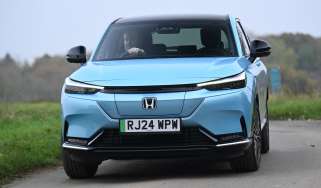MG4 EV - Interior, design and technology
The MG4 EV has a smart-looking cabin, but the fit and finish could be a little better

The all-electric MG4 benefits from sitting on the manufacturer’s new Modular Scalable Platform (MSP). This architecture will underpin the next generation of battery-powered MG models, including a range of hatchbacks, SUVs and sports cars.
The exterior of the MG4 will polarise opinion, but its sharp, dramatic lines, angular headlights and twin aero rear spoiler (on Trophy and XPower versions) mean it won’t get lost in the crowd – particularly if you specify Volcano Orange (also only available on Trophy and XPower trims), Dynamic Red or Holborn Blue colour options. MG4 XPower models also get a few new colours, as well as unique 18-inch alloy wheels and a set of orange brake calipers behind them. Inside, there’s red stitching, some aluminium pedals, and the seats get some Alcantara trim, but don’t expect the kind of bold visual cues you’d have found in MG’s range in the early 2000s – the overall look isn’t much different to the Trophy.
What is the MG4 like inside?
A minimalist, spacious cabin is in keeping with current EV fashion, while there is more than a hint that MG has drawn inspiration from premium German brands in developing the MG4’s interior style. The steering wheel has a slightly squared-off look similar in design to the one found in the BMW iX, the digital instrument display could have come from the VW ID.3, and the column stalks wouldn’t seem out of place in an Audi model. All this should be seen as a positive because MG has made a solid attempt to create a modern, up-to-date interior.
What is the interior quality like?
Admittedly, some of the materials do reflect the cheaper price point of the MG4 EV, with the fit and finish not entirely up to the standard of other mainstream brands such as Hyundai and Kia. But the overall impression remains positive, and the cabin looks smart enough.
Sat-nav, stereo and infotainment
The first thing that strikes you about the 10.25-inch display is how sharp the resolution is, while the row of physical buttons below are welcome. It’s also useful that there’s a row of shortcuts permanently on the right of the screen within easy reach of the driver (unlike in the Fiat 500, which places them on the far left, closer to the passenger), making it easier to get to the sat-nav, stereo, phone, and car setting screens. You can also set the air-con controls up as a shortcut from a button on the steering wheel that will allow you to adjust the fan speed and temperature using one of the thumb-controlled toggle switches.
However, we have noticed that it isn’t the most responsive screen during our long term testing. We’ve found that the menu screens can be awkward to use due to the small icons and text being hard to see at a glance while on the move. The Renault Megane E-Tech, has a much larger and more responsive screen that’s much easier to use on the move.
Apple CarPlay and Android Auto smartphone connectivity is standard, though neither is wireless. Speaking of wireless, you’ll need to get a top-spec Trophy or XPower to get a wireless phone charging pad. It is a shame you can’t add an upgraded sound system like you can on some of its rivals because you’ll need to crank up the volume at motorway speeds to offset the wind noise.
More reviews
Car group tests
In-depth reviews
Long-term tests
Which Is Best
Most Economical
- Name180kW Trophy EV Extended Range 77kWh 5dr Auto
- Gearbox typeAuto
- RRP£36,139












